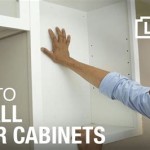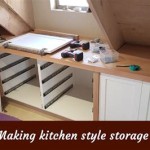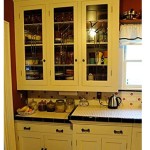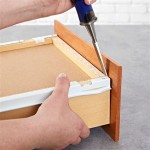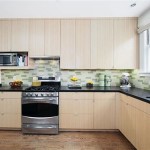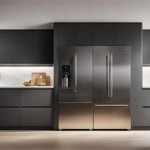How to Fix Kitchen Cabinets Together
Kitchen cabinets, crucial for storage and aesthetics, are often installed as individual units secured together to form a unified system. Understanding the proper techniques for fixing these cabinets together ensures structural integrity, proper alignment, and a visually appealing finished product. This article outlines the necessary steps and considerations for successfully joining kitchen cabinets during installation or repair.
Effective cabinet joining requires careful planning and the right tools. Before beginning the process, one must assess the cabinet types, the available space, and the desired configuration. Accurate measurements and a clear understanding of the cabinet layout are essential for a successful installation. Improperly aligned or inadequately secured cabinets can lead to functional problems, such as drawers and doors that don't close correctly, as well as potential safety hazards.
The primary goal of fixing cabinets together is to create a seamless and stable structure. This involves ensuring that the cabinet faces are flush, the edges are aligned, and the connecting hardware is securely fastened. Different methods may be employed depending on the cabinet construction, but the underlying principles remain the same: achieving a strong, level, and aesthetically pleasing connection.
Key Point 1: Preparing the Cabinets for Joining
The initial step involves laying out the cabinets in the desired order and ensuring they are level. This is crucial for preventing misalignments and ensuring a uniform appearance. Shims may be necessary to compensate for uneven floors or walls. A spirit level or laser level is essential for accurate leveling. Place the cabinets in their approximate final positions, allowing enough space to maneuver and adjust them.
Once the cabinets are positioned, inspect the adjoining surfaces for any imperfections or obstructions. Remove any debris, such as sawdust or dried glue, that could interfere with a flush connection. Sanding the adjoining surfaces can also improve the contact and adhesion between the cabinets. This step is particularly important for cabinets with painted or finished surfaces.
Clamping the cabinets together temporarily allows for accurate marking and drilling of pilot holes. Use clamps that are appropriate for the size and material of the cabinets, ensuring that they do not damage the surfaces. Apply even pressure to avoid warping or distorting the cabinets. This preliminary clamping provides a visual check of the alignment and allows for final adjustments before drilling.
Pilot holes are essential for preventing the screws from splitting the wood. Use a drill bit that is slightly smaller than the diameter of the screws. Drill the pilot holes through the cabinet frames where they will be joined together. The number of pilot holes will depend on the size and weight of the cabinets, but a minimum of two pilot holes per connection point is generally recommended. Ensure that the pilot holes are aligned on both cabinets for a secure and straight connection.
Apply wood glue to the adjoining surfaces of the cabinet frames. Wood glue provides an additional layer of adhesion and strengthens the joint. Use a high-quality wood glue that is specifically designed for cabinet making. Apply an even layer of glue to both surfaces and allow it to become slightly tacky before joining the cabinets. Avoid using excessive glue, as it can squeeze out of the joint and require cleanup.
Key Point 2: Techniques for Securing Cabinets
There are several methods for securing cabinets together, each with its own advantages and disadvantages. The most common method involves using screws to fasten the cabinet frames together. This provides a strong and relatively easy-to-implement solution. Another method involves using bolts and washers for added strength, particularly for heavier or high-stress applications. Cabinet stiles are the vertical frame pieces that make for easier and stronger connecting points.
When using screws, select screws that are long enough to penetrate both cabinet frames securely but not so long that they protrude through the other side. Use screws that are specifically designed for wood, as they have a sharper thread that provides better holding power. Countersink the screws to ensure that the heads are flush with the surface of the cabinet frame. This creates a clean and professional appearance and prevents the screw heads from interfering with the installation of doors or drawers.
Bolts and washers provide a more robust connection than screws, making them suitable for heavy-duty applications. Drill through both cabinet frames and insert the bolts. Use washers on both sides of the cabinet frames to distribute the pressure and prevent the bolts from pulling through the wood. Tighten the nuts securely, but avoid over-tightening, as this can damage the cabinet frames.
Cabinet joining screws, often self-tapping, are designed specifically for connecting cabinet frames. These screws have a specialized head that minimizes splitting and provides a clean, flush finish. They are also typically coated to prevent corrosion. Using cabinet joining screws can simplify the installation process and provide a professional-looking result.
Pneumatic nail guns can be used to tack the cabinets together before final fastening with screws or bolts. This provides temporary support and helps to keep the cabinets aligned while the glue dries. Use nails that are appropriate for the thickness and material of the cabinet frames. Avoid using excessive nails, as this can weaken the wood.
Key Point 3: Ensuring Alignment and Stability
Maintaining proper alignment is crucial throughout the cabinet joining process. Regularly check the alignment of the cabinet faces and edges using a straight edge or level. Make adjustments as needed to ensure that the cabinets are perfectly flush and aligned. Misalignments can be difficult to correct later on, so it is important to catch and address them early in the process.
Clamps are indispensable for maintaining alignment while the glue dries and the screws or bolts are tightened. Apply clamps to the top, bottom, and middle of the cabinet frames to ensure even pressure and prevent warping. Use clamps with rubber pads to protect the cabinet surfaces from damage. Allow the glue to dry completely before removing the clamps.
After the cabinets are secured together, check for any gaps or imperfections. Fill any gaps with wood filler and sand them smooth. Apply touch-up paint or stain to match the existing finish. This will create a seamless and professional-looking connection.
Reinforcing the joints with corner braces or metal brackets can provide additional stability, especially for larger or heavier cabinets. Install the corner braces or metal brackets on the inside of the cabinets, ensuring that they are securely fastened to both cabinet frames. This will help to prevent the cabinets from shifting or separating over time.
Once the cabinets are joined and installed, test the functionality of the drawers and doors. Ensure that they open and close smoothly and that they are properly aligned. Make any necessary adjustments to the hinges or drawer slides to correct any issues. Properly functioning drawers and doors are essential for the usability and longevity of the kitchen cabinets.
The level of the entire assembled cabinet structure is also critical. Even with individual cabinets leveled before assembly, the combined unit might require shimming to ensure a perfectly horizontal plane. This is particularly important for countertops, as an uneven surface is both aesthetically displeasing and functionally problematic.
Connecting cabinet boxes that house sinks or appliances requires special attention. Ensure sufficient clearance for plumbing or electrical connections. Reinforce the cabinet's structural integrity around these openings to compensate for any weakening caused by the cutouts. Water-resistant sealants should be used around the sink cabinet to prevent water damage to the wood.
For cabinets installed against walls, consider the wall’s squareness. Walls are frequently not perfectly square, which can create gaps between the cabinet and the wall. Scribing the cabinet – carefully cutting the cabinet to match the wall’s contour – can solve this issue, creating a tight, seamless fit. Using filler strips is another option for concealing minor gaps.
In conclusion, fixing kitchen cabinets together requires careful planning, precise execution, and attention to detail. By following these steps and considerations, individuals can achieve a strong, stable, and aesthetically appealing cabinet installation. Proper cabinet joining enhances the functionality and longevity of the kitchen, creating a valuable and enjoyable space for years to come.

How To Connect Your Kitchen Cabinets Diy Kitchens Advice

How To Install Kitchen Cabinets Diy Family Handyman

Home Repair How To Fix Kitchen Cabinets Diy

How To Install Kitchen Cabinets The Wall And Floor With Ease

Diy Stacked Kitchen Cabinets Frills And Drills

How To Attach Cabinets Together Pa Kitchen

Kitchen Cabinets 9 Easy Repairs Diy Family Handyman

How To Install Base Cabinets With Wickes

How To Install Kitchen Cabinets With Pictures Wikihow

Kitchen Cabinets Replace Or Reface C W Appliance Service

